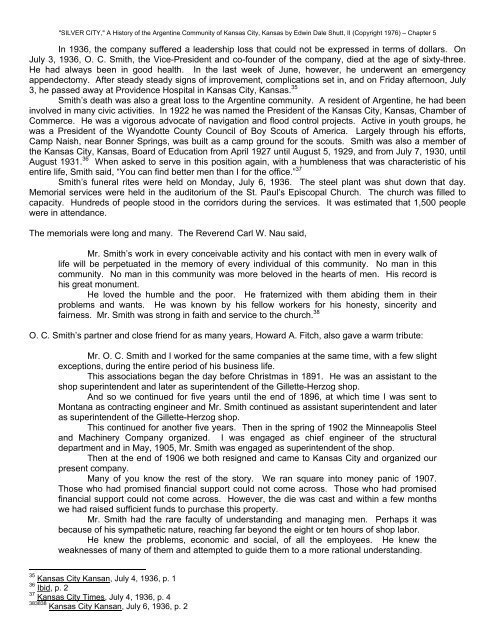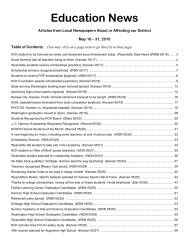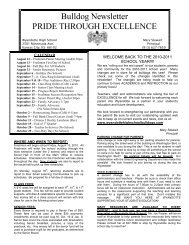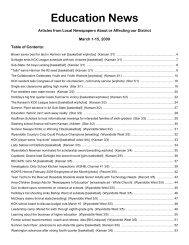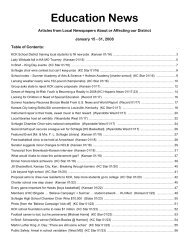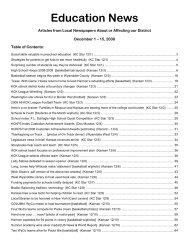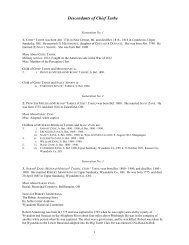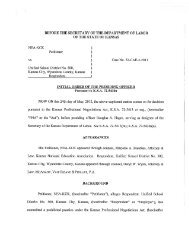Chapter V - Kansas City, Kansas Public Schools
Chapter V - Kansas City, Kansas Public Schools
Chapter V - Kansas City, Kansas Public Schools
Create successful ePaper yourself
Turn your PDF publications into a flip-book with our unique Google optimized e-Paper software.
"SILVER CITY," A History of the Argentine Community of <strong>Kansas</strong> <strong>City</strong>, <strong>Kansas</strong> by Edwin Dale Shutt, II (Copyright 1976) – <strong>Chapter</strong> 5<br />
In 1936, the company suffered a leadership loss that could not be expressed in terms of dollars. On<br />
July 3, 1936, O. C. Smith, the Vice-President and co-founder of the company, died at the age of sixty-three.<br />
He had always been in good health. In the last week of June, however, he underwent an emergency<br />
appendectomy. After steady steady signs of improvement, complications set in, and on Friday afternoon, July<br />
3, he passed away at Providence Hospital in <strong>Kansas</strong> <strong>City</strong>, <strong>Kansas</strong>. 35<br />
Smith’s death was also a great loss to the Argentine community. A resident of Argentine, he had been<br />
involved in many civic activities. In 1922 he was named the President of the <strong>Kansas</strong> <strong>City</strong>, <strong>Kansas</strong>, Chamber of<br />
Commerce. He was a vigorous advocate of navigation and flood control projects. Active in youth groups, he<br />
was a President of the Wyandotte County Council of Boy Scouts of America. Largely through his efforts,<br />
Camp Naish, near Bonner Springs, was built as a camp ground for the scouts. Smith was also a member of<br />
the <strong>Kansas</strong> <strong>City</strong>, <strong>Kansas</strong>, Board of Education from April 1927 until August 5, 1929, and from July 7, 1930, until<br />
August 1931. 36 When asked to serve in this position again, with a humbleness that was characteristic of his<br />
entire life, Smith said, “You can find better men than I for the office.” 37<br />
Smith’s funeral rites were held on Monday, July 6, 1936. The steel plant was shut down that day.<br />
Memorial services were held in the auditorium of the St. Paul’s Episcopal Church. The church was filled to<br />
capacity. Hundreds of people stood in the corridors during the services. It was estimated that 1,500 people<br />
were in attendance.<br />
The memorials were long and many. The Reverend Carl W. Nau said,<br />
Mr. Smith’s work in every conceivable activity and his contact with men in every walk of<br />
life will be perpetuated in the memory of every individual of this community. No man in this<br />
community. No man in this community was more beloved in the hearts of men. His record is<br />
his great monument.<br />
He loved the humble and the poor. He fraternized with them abiding them in their<br />
problems and wants. He was known by his fellow workers for his honesty, sincerity and<br />
fairness. Mr. Smith was strong in faith and service to the church. 38<br />
O. C. Smith’s partner and close friend for as many years, Howard A. Fitch, also gave a warm tribute:<br />
Mr. O. C. Smith and I worked for the same companies at the same time, with a few slight<br />
exceptions, during the entire period of his business life.<br />
This associations began the day before Christmas in 1891. He was an assistant to the<br />
shop superintendent and later as superintendent of the Gillette-Herzog shop.<br />
And so we continued for five years until the end of 1896, at which time I was sent to<br />
Montana as contracting engineer and Mr. Smith continued as assistant superintendent and later<br />
as superintendent of the Gillette-Herzog shop.<br />
This continued for another five years. Then in the spring of 1902 the Minneapolis Steel<br />
and Machinery Company organized. I was engaged as chief engineer of the structural<br />
department and in May, 1905, Mr. Smith was engaged as superintendent of the shop.<br />
Then at the end of 1906 we both resigned and came to <strong>Kansas</strong> <strong>City</strong> and organized our<br />
present company.<br />
Many of you know the rest of the story. We ran square into money panic of 1907.<br />
Those who had promised financial support could not come across. Those who had promised<br />
financial support could not come across. However, the die was cast and within a few months<br />
we had raised sufficient funds to purchase this property.<br />
Mr. Smith had the rare faculty of understanding and managing men. Perhaps it was<br />
because of his sympathetic nature, reaching far beyond the eight or ten hours of shop labor.<br />
He knew the problems, economic and social, of all the employees. He knew the<br />
weaknesses of many of them and attempted to guide them to a more rational understanding.<br />
35 <strong>Kansas</strong> <strong>City</strong> Kansan, July 4, 1936, p. 1<br />
36 Ibid, p. 2<br />
37 <strong>Kansas</strong> <strong>City</strong> Times, July 4, 1936, p. 4<br />
383838 <strong>Kansas</strong> <strong>City</strong> Kansan, July 6, 1936, p. 2


